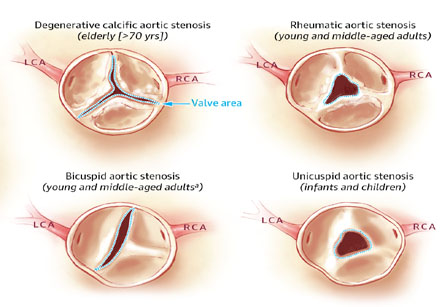Valvulotomy
Introduction
When stenosis of the valve occurs, there is obstruction to the blood flow and the heart muscle has to work extremely hard to pump blood out of the heart. This often results in heart failure. Aortic stenosis is causes severe problems in circulation, therefore it is considered as prototype for correction of stenosis. The only effective treatment for aortic stenosis is to relieve the obstruction in the valve, usually by surgically replacing the aortic valve. Aortic valve replacement is very effective treatment for aortic stenosis, it requires major open heart surgery and is relatively risky in some patients.
Procedure
Aortic valvulotomy is a less invasive approach of treating aortic stenosis. In valvulotomy, a balloon catheter is passed across the aortic valve and is inflated under high pressure. Inflating the balloon causes fracture in some of the calcium deposits on the valve. This allows the valve to open more completely, thus relieving a part of the obstruction.
Valvulotomy is considered as a good option for young patients with congenital forms of aortic stenosis. However, in older people with heavily calcified aortic valves, the results of valvulotomy have not been good.
Iran is among the top 10 countries in treating cardiovascular diseases, while it ranks first in the Middle East

According to research on elderly patients, severe complications such as stroke, aortic regurgitation, and myocardial infarction occurred in approximately 10 to 20 percent of patients. The mortality rate or rate of death in hospital is also about 10 to 20 percent. Restenosis and clinical deterioration occur in most cases within 6 to 12 months. Also, the long-term outcome after valvulotomy resembles the natural history of untreated aortic stenosis.
The rate of serious complications in elderly patients from valvulotomy (especially stroke, heart attack, and aortic regurgitation) is very high. Up to 20% of these patients usually die before leaving the hospital. This complication rate is higher than that found in elderly patients who have aortic valve replacement.
Sometimes, valvulotomy simply does not work very well and the long-term outcome is the same as for patients who receive no treatment at all.
According to research on elderly patients, severe complications such as stroke, aortic regurgitation, and myocardial infarction occurred in approximately 10 to 20 percent of patients.
Despite these results, valvulotomy is still being used. For example, valvulotomy can be employed as a bridging procedure until the valve replacement surgery can be performed. It is useful for temporary improvement of cardiac function sufficiently to allow open heart surgery to proceed more safely.
However, considering the negative results often seen with valvulotomy in elderly patients, it should be made sure to discuss these issues with the cardiologist and also about other options available. In addition to surgical valve replacement, these other options may include a different type of catheter-based treatment for aortic stenosis, called as transcatheter aortic valve implantation (TAVI).
The clinical and pathological features of pulmonary stenosis with a closed ventricular septum have recently been presented by scientists. Pure pulmonary stenosis is nearly always valvular and may lead to diverse effects, depending upon its severity and potential patency of the foramen ovale. At first the symptoms may be mild and the patient can grow as well as develop normally. Therefore it is important to emphasize on findings of physical signs in such cases.
The stenosis may not be severe enough and the patient may be only slightly limited by exertion, but he may lead an active life and reach a good age without developing cyanosis. It is usually difficult in these patients to tell during life if the foramen ovale is sealed or not. Several patients in this series are generally acyanotic in childhood and appear to belong to this group. But in due time they can became cyanotic. Many other patients have been seen who are at present in this group and in some of them the diagnosis has been confirmed by cardiac catheterization.